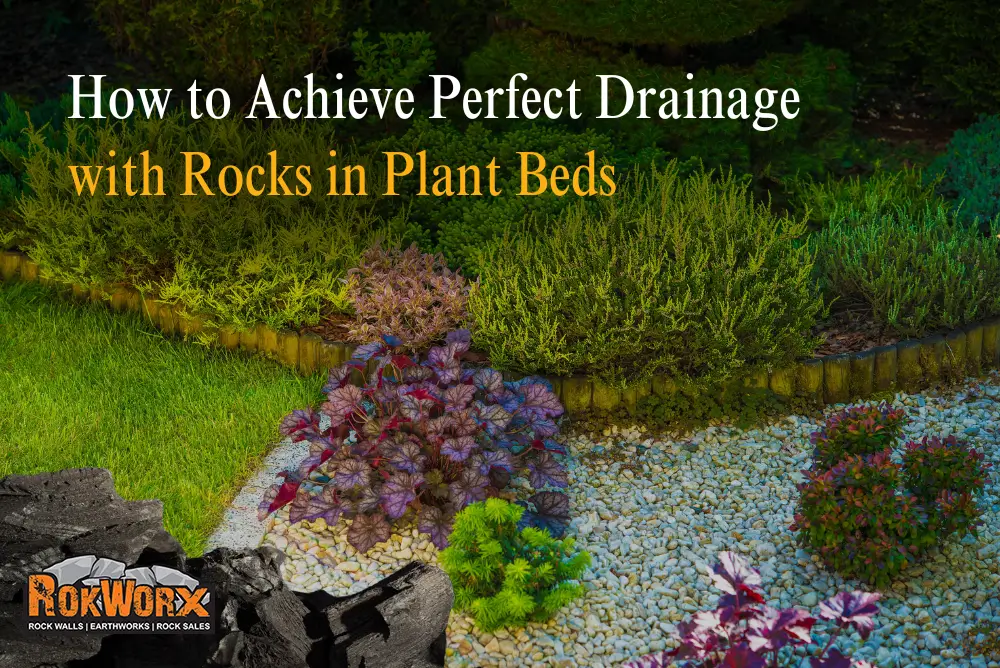Too much water in garden beds kills plants. Roots rot, soil compacts and nothing thrives. That’s why drainage is key. Rocks fix this. They don’t just look nice—they help water move. Many homeowners turn to landscaping rocks in Melbourne for drainage that works and gardens that last.
Let’s break down how to use rocks the right way to create better drainage, avoid soggy soil and keep your plant beds healthy all year.
Why Drainage Matters in Plant Beds
Plants need water, but not too much. When soil stays wet, air can’t reach the roots. That leads to rot, disease and weak growth. Good drainage gives plants what they need—moisture and airflow.
Rocks help by letting water flow through the soil and away from the root zone. They form a base layer that keeps soil from staying wet too long. This is especially helpful in clay-heavy soil or raised garden beds.
Setting it up right is simple. Use coarse rock at the bottom, layer it with landscape fabric, then top it with quality soil. That’s it. But the details matter—like what rock you choose and how deep the layer goes. To do this properly, make sure you understand rock garden drainage tips you should know to avoid the most common mistakes.
Choosing the Right Rocks for Drainage
Not all rocks work well. Some trap water. Others let it flow. For proper drainage, crushed rock or scoria is best. These are rough and porous, so they leave space for water to move. Avoid smooth river pebbles for base layers. They’re too tight and block flow.
Coarse gravel or crushed granite works under most garden beds. Lava rock is great too—light, porous and long-lasting. These rocks not only drain water but also hold a little moisture, which helps in dry seasons.
Use the right size for your space. Smaller rocks are better for tight beds or planters. Larger rocks work in bigger areas or at the top for visual appeal. When it comes to what size rock is best for landscaping beds, you really need to first take into account the layout and soil type.
Soil and Rock Compatibility
Good drainage needs more than just rocks. The soil above them matters too. Poor soil holds water no matter what you do underneath. That’s why your rock layer and soil must work together.
If you have heavy clay soil, break it up. Mix in compost or coarse sand to help it drain. For sandy soils, add organic matter to slow drainage and keep roots from drying out.
Never dump soil directly on rocks. Use landscape fabric in between. This keeps the soil in place and lets water flow. Without that barrier, the soil clogs the rocks and ruins the drainage. Want to match the right rock and soil combo? Check out different types of landscaping rocks and how to use them in garden beds across different soil types.
Raised Beds vs Ground Beds
Raised beds and ground beds need different drainage setups. In raised beds, you control every layer—from the rocks to the soil mix. It’s easier to manage, but beds can dry out fast if the layers aren’t right.
For raised beds:
- Use 10–20 cm of crushed rock at the bottom
- Add fabric to stop soil from clogging the rocks
- Fill with soil that includes compost and sand
Ground beds need more prep. Dig deeper, break up compact soil, and lay a base rock layer under the planting area. If your garden is flat, slope it slightly so water moves out instead of pooling. If it’s sloped already, manage the flow with terraces or rock walls.
Raised beds need drainage holes if they’re built on a solid surface. Otherwise, water will just sit inside. Ground beds need rock-lined trenches or paths to help water escape naturally.
Using Rocks as Surface Mulch
Rocks aren’t just for under the soil. They also make great mulch. When placed on top, rocks slow water runoff, reduce evaporation and keep soil cool. Unlike bark, they don’t break down or blow away.
Rock mulch also:
- Stops weeds
- Prevents soil from compacting
- Reflects light and heat for better plant health
Scoria and lava rock are ideal for surface mulch. Crushed stone adds a modern touch, while river pebbles soften edges and look natural. Just don’t layer them too thick—2–5 cm is enough to do the job.
Use mulch rocks around native plants, succulents or drought-resistant shrubs. These types of gardens stay cleaner, use less water and need little upkeep when rocks are part of the mix.
Drainage Solutions for Sloped Gardens
Hills and slopes bring challenges. Water runs fast downhill. Without planning, it erodes soil, damages roots and leaves puddles in low spots.
The fix? Build in features that slow water down and guide it. Use crushed rock in dry creek beds, or stack large rocks to form terraces. These hold soil and stop water from rushing straight down.
Here’s a real example: a garden in the Mornington Peninsula had a steep slope that was always wet and muddy. The owners used sandstone blocks to terrace the yard, added layers of scoria behind each wall, and filled the top with native plants. After one wet season, there were no signs of waterlogging and the plants took off.
Rocks can do more than drain water. They shape the space, create structure and support better plant growth, even on tough blocks.
Mistakes That Ruin Drainage
Rocks are simple—but easy to misuse. Common drainage mistakes include:
- Skipping the fabric between rock and soil
- Using smooth stones that block water flow
- Over-compacting each layer
- Forgetting to plan where water will exit
- Using plastic sheets under soil
Another big mistake is layering different materials without transition zones. For example, if you go from sand to clay, water stops. This is called the “perched water table.” It leads to pooling, no matter how good your rocks are.
Check how your garden drains after rain. If you see standing water, it’s time to adjust your setup.
Keeping Your Drainage System Working
Rocks don’t wear out, but drainage systems still need care. Over time, soil shifts, debris builds up and rocks can get buried.
Keep things working by:
- Raking surface rocks to remove leaves and dirt
- Replacing mulch that sinks below the soil
- Clearing out blocked dry creek beds
- Adding fresh scoria or gravel when needed
After storms, walk the garden and look for puddles or slow-draining spots. Fix small issues early before they damage roots or wash away soil.
Drainage doesn’t need to be high maintenance. A few minutes of care now and then keeps your rock system working for years.
FAQs
1. How deep should the rock layer be for plant bed drainage?
It depends on your bed type and soil. For raised beds, aim for 10–20 cm of crushed rock at the bottom. For shallow ground beds, 5–10 cm can work if the soil drains well. In heavy clay soil, go deeper—up to 30 cm—so water has more room to move before reaching compact layers. Use landscape fabric above the rock layer to keep soil from washing down and clogging gaps. This helps maintain flow and stops root rot. The key is to create a steady channel beneath the soil for water to pass through and exit.
2. Can I use river rocks for drainage in plant beds?
River rocks are best for decoration, not drainage. Their smooth, rounded shape makes them pack tightly, which blocks water from moving freely. They look great on top of garden beds or along paths but don’t work well under the soil. If you place them at the base of a bed, you risk water pooling above them. For actual drainage, use angular rocks like crushed granite or scoria. These create space between pieces, allowing water to flow quickly and keeping soil from getting soggy.
3. Will rocks change the pH or quality of my soil?
Most landscaping rocks are stable and won’t change your soil. Crushed granite, scoria, basalt and river stones are pH neutral. They won’t release chemicals or alter your soil’s health. The one exception is limestone, which can raise soil pH over time. That’s fine for some plants but harmful to others. When in doubt, stick with neutral rock types. Also, wash your rocks before use. Dust or debris from processing can affect soil texture, especially in smaller beds. Clean rocks give you clean results.
4. Is using rocks better than sand for improving drainage?
Yes—rocks work better for long-term drainage. Sand can compact over time, especially when wet, which slows water flow. Rocks hold their shape and leave space between pieces. That means water keeps moving down through the layers. Sand is better used as part of your soil mix, not a drainage layer. Use rocks under the soil, and sand or compost in the soil itself. Together, they create a system that drains well and still holds moisture where roots can reach it.
5. How do I combine rocks and native plants for a low-maintenance garden?
Start by picking native plants that thrive in your soil type. Then prep your bed with a drainage layer of crushed rock or scoria, followed by good soil. Use surface rock mulch to lock in moisture and stop weeds. Place larger rocks around the base of larger shrubs to slow runoff and hold soil. This setup works well for plants like kangaroo paw, grevillea and banksia. The rocks help drainage, and the natives need less watering. Together, they create a garden that handles heat, resists pests and needs little upkeep.
Build Beds That Last with the Right Rocks
Healthy garden beds start underground. When water drains right, plants grow stronger and stay disease-free. Rocks are one of the easiest tools to make that happen. They build structure, move water and keep soil where it belongs.
In an age of tougher droughts, heavier rains and busier lives, drainage matters more than ever. Good rock layers don’t just solve problems—they prevent them. Whether you’re starting fresh or fixing a soggy garden, the right rocks make a lasting difference.
For top-grade landscaping rocks in Melbourne that are built for drainage, durability and design, visit Rokworx. Build from the ground up—and build it to last.
Please call us today for more information at (03) 9000 0588 or leave a message.


